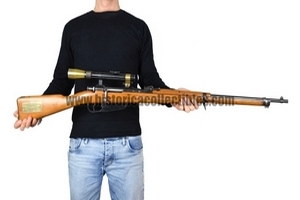Carcano 91/41 Experimental (Sniper Version), 1942
Experimental Carcano 91/41, one of the very rare examples existing today which testify to the attempt by the high commands of the Royal Italian Army to arm some departments with one of the most lethal, insidious and psychologically devastating weapons which saw them as major protagonists during the second world war: snipers.
The first attempts to arm some army units, making available to them selected marksmen equipped with sniper rifles, took place already late in the war and this was probably one of the reasons why, the very few examples of Carcano 91/41 with optics, they remained at an experimental level.
This prototype was developed within the "Experimental Workshop" under the Istituto Superiore Tecnico d'Artiglieria of the Royal Army which was the only body able to organize and officially carry out experiments and experiments which should have subsequently resulted in a real mass production.
Among other things, the Higher Technical Institute of Artillery, starting from 1940, oversaw the Terni Weapons Factory: Here is the answer to why the only two known examples of Experimental Carcano 91/41 equipped with La Filotecnica optics are be produced in Terni.
The superior body that regulated rules and regulations on weapons and ammunition was the Technical Service for Weapons and Ammunition or better known as the Technical Service of Artillery and its structure was as follows:
- a higher directorate of the technical service of weapons and ammunition;
- an artillery technical college with experimental workshop and chemical and technological sections;
- a shooting table office;
- experience centres, the number and type of which are established by royal decree, upon proposal of the Minister for War in agreement with the Minister for Finance, in relation to the needs of the service.
The Carcano in question is the 91/41 model to which some significant modifications were made such as the twisted lever bolt to allow loading and the two grooves along the hand guard, to allow the shooter a better grip and greater stability when shooting .
Furthermore, the fundamental modification was the addition of two specific attachments, useful for equipping the rifle with a precision telescope. The optics in question were once again "La Filotecnica Milano", the telescope produced in 1917 was used to which the total transformation of the reticle was made which went from "Single Needle" to "T", allowing to increase the precision of target centering. The register of the reticle was changed and consequently the knurled ring went from being divided into 100, 200 and 300 meters, to "30", "60", "90", "120", "150", "180", and 200 meters.
The Experimental Workshop placed a plaque on the buttstock bearing data and protocols, probably a technical register of weapons experiments.
This very rare specimen drastically re-evaluates and repositions the opinion that was held about our Commands during the Second World War which maintained that there was no interest in preparing a war organized with departments specialized in high precision shooting, or snipers, which patrolled the enemy's forced passages.
Exemplary of very high historical and collectible interest.


